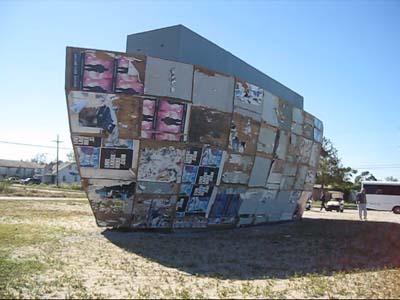One of my most unforgettable experiences with the intersection of art and the life of a city was Prospect.1, an international contemporary art exhibition intended to assist in New Orleans’s economic recovery from the devastation wrought by Hurricane Katrina and the governmental neglect that preceded and followed it. (Although Prospect New Orleans was intended to launch a biennial, cost overruns and the Great Recession have turned it into a more occasional series of exhibitions. Thee next one, which is to be curated by Los Angeles Museum of County Art chief curator — and former Menil Collection curator — Franklin Sirmans, was supposed to happen this year but was postponed until 2014 so as not to compete with bigger, more glamorous extravaganzas like the Venice Biennale.)
What made the memory so powerful wasn’t just the art but the way Prospect.1 director and chief curator Dan Cameron, who’s now the TK at the Orange County Museum of Art, sited many of the installations in the Lower Ninth Ward and other ravaged areas — the idea being to force biennial-hoppers to confront the lingering wreckage firsthand. I vividly remember the jaded assholes on the press bus, most of whom had forgotten about more art fairs and biennials than I’ve ever attended — becoming a little less jaded and a little less asshole-ish with every stop.
So when I read that Kevyn Orr, the emergency manager for Detroit appointed by Michigan Gov. Rick Snyder, plans to take the city’s creditors on a bus tour of the parts of the city most ravaged by the departure of some 1.2 million residents, I wanted to see some of the areas the Detroit News’s Laura Berman recommended for “a shock-and-awe tour of Detroit that skips the niceties.” What I saw was indeed shocking and all too reminiscent of the post-Katrina Lower Ninth Ward, only on a larger, seemingly infinite scale. Here’s hoping Orr’s tour also makes Detroit’s creditors a little less jaded and a little less asshole-ish at every stop and, as Berman puts it, jolts “hard-nosed creditors out of balky reluctance and into accepting his offer of a settlement: More or less, 10 cents on the dollar.”
In my Facebook photo album, I’m alternating snapshots I took from my self-guided tour with some I took at the Detroit Institute of Arts, whose truly world-class — to borrow a term many Houstonians cringe-inducingly use in every other sentence — collection Orr has eyed for the auction block, because ultimately I can’t separate the memories.
From Toby Barlow’s article brilliantly explaining why the banks, not the DIA, should be the ones forced to sell art from their collections:
Over the past decade, the banks have evicted many, many people in Detroit from their homes. …
After these evictions occurred, the banks did not foreclose the homes. They simply let the houses rot.
In other words, as opposed to following the due diligence of a functioning system, wherein these banks would have gone through the legal process of actually foreclosing the home, earning back the home’s title, and then paying the taxes on the property until the property was sold to a new owner, they did nothing. They simply walked away.
So, for starters, they owe taxes on those homes. Not just a few homes; thousands of homes. That’s lot of taxes. When you’re done adding everything that’s owed, it’s probably worth more than a few Chagalls.
Then there’s this: by letting those homes rot, these banks caused the depreciation of all the other homes in all those neighborhoods, block after block, along nearly every avenue, street and boulevard. Each one of these abandoned homes pulls the value of all those other buildings down.
These banks were like the shark in Copley’s famous painting (at the Detroit Institute of Art, of course), attacking the vulnerable drowning figure in the water.
The victims were honest and hard working, and their homes were suddenly worth less. What followed was predictable: a shrinking tax base, the city unable to pay its bills, cut services. So now the police don’t show up, the firemen are understaffed, people are less safe, people move away, more homes stand empty, and the banks didn’t know or didn’t care. Having made the money they were going to make, they simply swam on.







